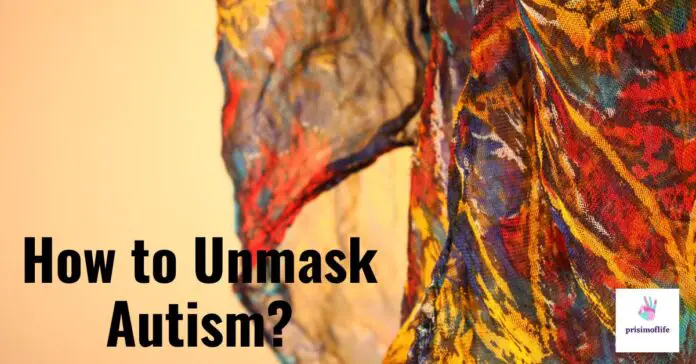
How to unmask autism? It is a serious question because autism can be hard to spot, especially in relatively young children or if they are particularly adept at hiding their symptoms. If you suspect your child may have autism, the first step is to have them evaluated by a professional who can accurately diagnose the condition and offer an action plan to help your child thrive. Here are some of the most common ways to unmask autism and get your child the help they need.
Autism can manifest itself in many different ways depending on the individual and their skills, but there are some general signs to look out for if you suspect someone might be autistic. If you have noticed that your child may have autism, the best thing to do is to have him, or her tested by qualified professionals and see what they say. Here are some of the main signs of autism, whether it’s an autism spectrum disorder (ASD) or just mild symptoms that warrant further investigation.
Ways to identify and help an autistic child
It’s more common than you think. A staggering 1 in 68 children have autism, a group of complex developmental brain disorders. It’s more common than pediatric cancer, diabetes, and AIDS combined, according to figures released by CDC researchers in 2013. However, it can be difficult for parents and doctors to distinguish autism from other disorders that impair communication and social skills, such as ADHD or cerebral palsy.
Here are three ways we might help autistic children reach their full potential:
- Better awareness of signs of autism in young children
- Using computerized tools as diagnostic aids
- Giving atypical kids new opportunities for learning
With these approaches, we may open doors for these kids without ever opening their skulls.
Early warning signs of autism
Look for signs of autism in children as early as possible. Early intervention can mean better outcomes and make a real difference in your child’s life. Some of these signs may seem like normal traits that many kids display, but they should be present before age two. The sooner you detect them and start treatment, the better off your child will be.
Some symptoms include: eye contact issues; trouble socializing; not making sense when they talk or use language inappropriately (for example, if they say something that makes no sense at all); delay in starting to speak or taking longer than normal to develop speech; lack of interest in other people or playing by themselves; and repetitive behaviors such as lining up toys or flipping light switches on and off.
Parenting an autistic child
What do I need to know? : Most parents of autistic children report they feel more isolated, misunderstood, and less confident than they expected when their child is diagnosed. Because ASD varies so much from person to person, some aspects of parenting your autistic child may not apply to you or your situation; however, most parents find these strategies helpful.
Dealing with public stigma
The prevalence of autism has risen substantially over the past two decades, yet there is still a stigma associated with its symptoms. According to a 2011 study by Yale University School of Medicine, autism is frightening in nearly half of all families dealing with an autistic child.
Since its recent spike in diagnoses, autism has also been featured prominently on TV shows like The Big Bang Theory, portraying autistic characters as socially awkward and prone to strange behavior. Because it is so often portrayed as being incredibly rare (and often scary), many people are surprised when they learn they know someone who has been diagnosed with autism.
Acceptance and commitment therapy
According to Dr. Dan Siegel, you can use acceptance and commitment therapy (ACT) to unmask autism and help your child be more engaged with others. According to Siegel, ACT is a type of cognitive-behavioral therapy (CBT) that helps promote psychological flexibility by encouraging individuals to engage in values-driven actions rather than being driven by anxiety or avoidance. This means assisting children to embrace their own internal processes instead of rejecting them, which can allow them to interact with others more easily.
Behavioral issues among autistic children
Autistic children may have some behavioral issues. When such a child starts crying, their parents must understand the specific reasons behind it. It is evident that autistic children do not cry for anything. There are many reasons why they do so, and some of them are: He might be feeling hungry or thirsty, he may be in pain, he may need more attention, or feel uncomfortable with something around him.
So when you notice your child crying due to any of these things, make sure you calm him down as soon as possible by feeding him, giving him water, or playing with him according to his choice. This will help your child get over his problem in no time, and he will start smiling again in no time!
Causes of autism spectrum disorder (ASD) in children
The incidence of autism spectrum disorder (ASD) has been increasing in recent years, but scientists still don’t know what causes ASD. According to a report published by CDC, 1 in 68 children had been identified with autism spectrum disorder (ASD) as of 2014. While there is no apparent cause for autism yet, studies have found that genetic mutations and environmental exposures play a part in developing ASD.
Researchers have uncovered several genetic causes of ASD and believe that many more will be discovered with further research. There are also risk factors linked to genetics that can predispose individuals to develop ASD. On the other hand, certain prenatal infections can increase brain development disorders like autism. I hope this article successfully provides information regarding how to unmask autism. If you like, please share your feedback in the comment section.
Suggested Atricles: https://prisimoflife.com/2022/01/28/how-long-do-you-hold-a-yoga-pose/










